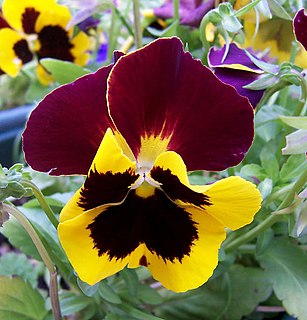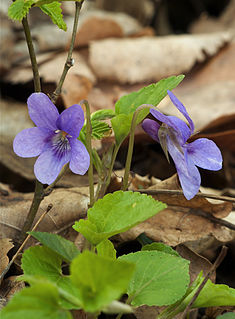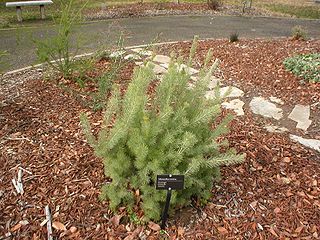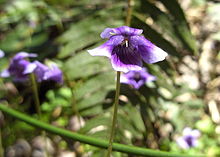
Epacris impressa, also known as common heath, is a plant of the heath family, Ericaceae, that is native to southeast Australia. French botanist Jacques Labillardière collected the species in 1793 and described it in 1805. Four forms have been identified, but no subspecies are recognised. Growing in heathland, shrubland or open forest, it is generally a small shrub around 0.5 to 1 m tall, with small stiff leaves. The red, pink or white tube-like flowers appear from late autumn to early spring. Honeyeater birds, particularly the eastern spinebill, feed upon the nectar of the flowers. It regenerates after bushfire by seed or by resprouting.

The garden pansy is a type of large-flowered hybrid plant cultivated as a garden flower. It is derived by hybridization from several species in the section Melanium of the genus Viola, particularly Viola tricolor, a wildflower of Europe and western Asia known as heartsease. Some of these hybrids are referred to as Viola × wittrockiana Gams ex Nauenb. & Buttler. For simplicity, the older name Viola tricolor var. hortensis is often used.

Viola is a genus of flowering plants in the violet family Violaceae. It is the largest genus in the family, containing between 525 and 600 species. Most species are found in the temperate Northern Hemisphere; however, some are also found in widely divergent areas such as Hawaii, Australasia, and the Andes.

Viola odorata is a species of flowering plant in the viola family, native to Europe and Asia. This small hardy herbaceous perennial is commonly known as wood violet, sweet violet, English violet, common violet, florist's violet, or garden violet. It has been introduced into North America and Australia.

Banksia ser. Dryandra is a series of 94 species of shrub to small tree in the plant genus Banksia. It was considered a separate genus named Dryandra until early 2007, when it was merged into Banksia on the basis of extensive molecular and morphological evidence that Banksia was paraphyletic with respect to Dryandra.

Viola hederacea, the Australian violet, is a species of flowering plant in the family Violaceae, native to Australia.

Banksia violacea, commonly known as violet banksia, is a species of shrub or tree in the plant genus Banksia. It generally grows as a small shrub to 1.5 m (5 ft) high with fine narrow leaves, and is best known for its unusually coloured dark purple-violet inflorescences. The colour of the inflorescences, short leaves, and flattened follicles which are sticky when young, help identify this species from others in the field. It is found in low shrubland in southern regions of Western Australia from Esperance in the east to Narrogin in the west, growing exclusively in sandy soils.

Banksia proteoides, commonly known as king dryandra, is a shrub endemic to Western Australia. It was known as Dryandra proteoides until 2007, when all Dryandra species were transferred to Banksia by Austin Mast and Kevin Thiele.

Banksia stuposa is a species of shrub that is endemic to the southwest of Western Australia. It has hairy stems, broadly linear pinnatifid leaves, golden yellow and white flowers in heads of one hundred or more, and hairy, egg-shaped follicles.
Banksia viscida, commonly known as sticky dryandra, is a small shrub known only from four laterite hills in semi-arid inland Western Australia. Known until recently as Dryandra viscida, it is thought to be rare but not threatened.
Banksia xylothemelia is a sprawling woody shrub of the family Proteaceae endemic to southern Western Australia, one of the many species commonly known as dryandras and until recently called Dryandra xylothemelia. To date it is almost unknown in cultivation.

Adenanthos sericeus, commonly known as woolly bush, is a shrub native to the south coast of Western Australia. It has bright red but small and obscure flowers, and very soft, deeply divided, hairy leaves.

Eucalyptus cornuta, commonly known as yate, is a tree species, sometimes a mallee and is endemic to the southwest of Western Australia. It has rough, fibrous bark on all or most of its trunk, smooth bark above, mostly lance-shaped adult leaves, elongated flower buds in groups of eleven or more, yellowish flowers and cylindrical to cup-shaped fruit. It is widely cultivated and produces one of the hardest and strongest timbers in the world.

Viola betonicifolia, commonly known as the arrowhead violet, showy violet or mountain violet, is a small perennial of the genus Viola, which contains pansies and violets. It occurs from India and Pakistan in southern Asia throughout eastern Australia and Tasmania. It grows in shaded habitat in forests.

Adenanthos obovatus, commonly known as basket flower, or, jugflower, is a shrub of the plant family Proteaceae endemic to Southwest Australia. Described by French naturalist Jacques Labillardière in 1805, it had first been collected by Archibald Menzies in 1791. Within the genus Adenanthos, it lies in the section Eurylaema and is most closely related to A. barbiger. A. obovatus has hybridized with A. detmoldii to produce the hybrid A. × pamela. Several common names allude to the prominent red flowers of the species. It grows as a many-stemmed spreading bush up to 1 m (3.3 ft) high, and about 1.5 m (4.9 ft) across, with fine bright green foliage. Made up of single red flowers, the inflorescences appear from April to December, and peak in spring.

Eucalyptus torquata, commonly known as coral gum or Coolgardie gum, is an endemic tree of Western Australia. The species is cultivated for use in gardens and as a street tree.

Adenanthos cuneatus, also known as coastal jugflower, flame bush, bridle bush and sweat bush, is a shrub of the family Proteaceae, native to the south coast of Western Australia. The French naturalist Jacques Labillardière originally described it in 1805. Within the genus Adenanthos, it lies in the section Adenanthos and is most closely related to A. stictus. A. cuneatus has hybridized with four other species of Adenanthos. Growing to 2 m high and wide, it is erect to prostrate in habit, with wedge-shaped lobed leaves covered in fine silvery hair. The single red flowers are insignificant, and appear all year, though especially in late spring. The reddish new growth occurs over the summer.

Melaleuca wilsonii, commonly known as Wilson's honey-myrtle or violet honey-myrtle, is a plant in the myrtle family, Myrtaceae, native to parts of South Australia and Victoria. It is a shrub with narrow, pointed leaves and heads of purplish-pink flowers on the sides of the branches. It is adaptable to a wide range of soils, frost hardy and often cultivated.
Grevillea cyranostigma, commonly known as the Carnarvon grevillea or green grevillea, is a shrub species that is endemic to Queensland in Australia. It was first formally described by Don McGillivray in 1975. He named it cyranostigma after Edmond Rostand's Cyrano de Bergerac, as its long stigma was reminiscent of the character's protruding nose. The type specimen was collected between 1890 and 1895 by Harriette Biddulph of Mount Playfair Station, who was known for her collection of plants from the Carnarvon Range. The species appears to be related to Grevillea sericea and G. victoriae, and is distinguished by glossier leaves than the former and a less hairy perianth than both.
Viola eminens is a perennial, stolon-spreading herb in the genus Viola, native to southeastern Australia.
















